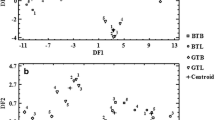Abstract
The present work has been demonstrated a developed method for the determination of Mn, Fe, Co, Ni, Cu, Zn, Mo, Cd, As, Cr, Pb, and V in different types of black teas collected from Saudi Arabia market using inductively coupled plasma mass spectrometry (ICP-MS). Each sample represents a well-mixed combination of ten packets from the same type collected from the market. Detection limits in ng g−1 were 76.06, 166.03, 5.94, 2.94, 18.29, 18.29, 9.00, 0.48, 0.48, 7.67, 3.07, and 4.21 for Mn, Fe, Co, Ni, Cu, Zn, Mo, Cd, As, Cr, Pb, and V, respectively. In order to validate the developed method, a certified reference material of green tea was analyzed. Further comparison with the results obtained from high-resolution continuum source atomic absorption spectrometry (HR-CS-AAS) was demonstrated. The obtained good agreement confirms the validity of the investigated method. Fortunately, the concentrations of the heavy metals locate on the range of the international values. The highest metal content was found in Al-Rabee tea, and this type results should be confirmed by using a large number of samples in order to have satisfied and confirmed statistical analysis results.
Similar content being viewed by others
References
Fernandez-Cáceres PL, Martin MJ, Pablos M, González AG (2001) Differentiation of tea (Camellia sinensis) varieties and their geographical origin according to their metal content. J. Agr Food Chem 49:4775–4779
Karimi G, Hasanzadeh MK, Nili A, Khashayarmanesh Z, Samieic Z, Nazari F, Teimuri F (2008) Concentrations and health risk of heavy metals in tea samples marketed in Iran. Pharmacology 3:164–174
Serafini M, Ghiselli A, Ferro-Luzzi A (1996) In vivo antioxidant effect of green and black tea in man. Eur J Clin Nutr 50:28–32
Grassi D, Desideri G, Giosia PD, De-Feo M, Fellini E, Cheli P, Ferri L, Ferri C (2013) Tea, flavonoids, and cardiovascular health: endothelial protection. Am J Clin Nutr 98(6):1660S–1666S
Kumar A, Nair AGC, Reddy AVR, Garg AN (2005) Availability of essential elements in Indian and US tea brands. Food Chem 89:441–448
Marcos A, Fisher A, Ree G, Hill SJ (1996) Preliminary study using trace element concentration and a chemometrics approach to determine the geological origin of tea. J Agri Atom Spect 113:521–525
Wróbel K, Wróbel K, Urbina EMC (2000) Determination of total aluminum, chromium, copper, iron, manganese, and nickel and their fractions leached to the infusions of black tea, green tea, Hibiscus sabdariffa, and Ilex paraguariensis (mate) by ETA-AAS. Biol Trace Elem Res 78(1–3):271–280
Matsuura H, Hokura A, Katsuki F, Itoh A, Haraguchi H (2001) Multielement determination and speciation of major-to-trace elements in black tea leaves by ICP-AES and ICP-MS with the aid of size exclusion chromatography. Anal Sci 17:391–398
Narin I, Colak H, Turkoglu O, Soylak M, Dogan M (2004) Heavy metals in black tea samples produced in Turkey. B Environ Contam Tox 72:844–849
Salvador MJ, Lopes GN, Filho VFN, Zucchi OLAD (2002) Quality control of commercial tea by x-ray fluorescence. X-Ray Spectrom 31:141–144
Desideri D, Meli MA, Roselli C, Feduzi L (2011) Polarized X ray fluorescence spectrometer (EDPXRF) for the determination of essential and non essential elements in tea. Microchem J 98:186–189
A. Szymczycha-Madeja, M. Welna, P. Pohl, Comparison and validation of different alternative sample preparation procedures of tea infusions prior to their multi-element analysis by FAAS and ICP OES, Food Anal Methods, May 2016, Volume 9, Issue 5, pp 1398–1411
P. Pohl, A. Dzimitrowicz, D. Jedryczko, A. Szymczycha-Madeja, M. Welna, P. Jamroz, The determination of elements in herbal teas and medicinal plant formulations and their tisanes, Journal of Pharmaceutical and Biomedical Analysis, In press 2016.
L. Polechońska, M. Dambiec, A. Klink, A. Rudecki, Concentrations and solubility of selected trace metals in leaf and bagged black teas commercialized in Poland, J Food Drug Anal, Volume 23, Issue 3, September 2015, Pages 486–492
Al-Oud SS (2003) Heavy metal contents in tea and herb leaves. Pakistan J Biol Sci 6:208–212
Ashraf W, Mian AA (2008) Levels of selected heavy metals in black tea varieties consumed in Saudi Arabia. B Environ Toxicol 81:101–104
Shaltout AA, Abdel-Aal MS, Welz B, Castilho INB (2013) Determination of Cd, Cu, Ni and Pb in black tea from Saudi Arabia using graphite furnace atomic absorption spectrometry after microwave-assisted acid digestion. Anal Lett 46(3):2089–2100
Shaltout AA, Khoder MI, El-Abssawy AA, Hassan SK, Borges DLG (2013) Determination of rare earth elements in dust deposited on tree leaves from Greater Cairo using inductively coupled plasma mass spectrometry. Environ Pollut 178:197–201
Aguilar MV, Laborda JM, Martínez-Para CM, González MJ, Meseguer I, Bernao A, Mateos CJ (1998) Effect of diabetes on the Tissular Zn/Cu ratio. J Trace Elem Med Bio 12(3):155–158
Roshchin AV, Ordzhonikidze KE, Shalganova IV (1980) Vanadium-toxicity, metabolism, carrier state. J Hyg Epid Microb Im 24(4):377–383
Achudume AC, Owoeye D (2010) Quantitative assessment of heavy metals in some tea marketed in Nigeria—bioaccumulation of heavy metals in tea. Health 2:1097–1100
Seenivasan S, Manikandan N, Muraleedharan NN, Selvasundaram R (2008) Heavy metal content of black teas from South India. Food Control 19:746–749
Szymczycha-Madeja A, Welna M, Pohl P (2012) Elemental analysis of teas and their infusions by spectrometric methods. Trac-Trends Anal Chem 35:165–181
Acknowledgments
The authors would like to extend their sincere appreciation to the Deanship of Scientific Research at King Saud University for its funding of this research through the research Group projects no RGP-306.
Author information
Authors and Affiliations
Corresponding author
Rights and permissions
About this article
Cite this article
Shaltout, A.A., Abd-Elkader, O.H. Levels of Trace Elements in Black Teas Commercialized in Saudi Arabia Using Inductively Coupled Plasma Mass Spectrometry. Biol Trace Elem Res 174, 477–483 (2016). https://doi.org/10.1007/s12011-016-0728-x
Received:
Accepted:
Published:
Issue Date:
DOI: https://doi.org/10.1007/s12011-016-0728-x




